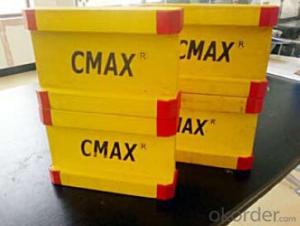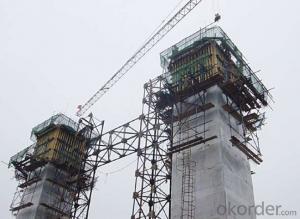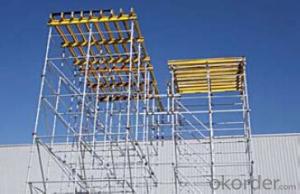Timber-Beam for formwork and scaffolding system
- Loading Port:
- Tianjin
- Payment Terms:
- TT OR LC
- Min Order Qty:
- 50 m²
- Supply Capability:
- 1000 m²/month
OKorder Service Pledge
OKorder Financial Service
You Might Also Like
Characteristics:
◆ Standardized production lines.
Supply capability: 3000m/day, Lmax = 6600mm.
◆ Finger jointing of the flange and web, the strength of timber beam is highly improved.
Max. shearing force failure load:40KN
◆ Well treated to prevent from water penetration or erosion, so the service life maximally extended.
Normally, CNBM timber beam H20 can be used for 4 to 5 years, the exact using time would depend on maintenance & storage.
◆ Robust caps at the end of the girders protect against damages.


- Q: What are the different locking mechanisms used in steel formwork?
- There are several different locking mechanisms used in steel formwork to ensure stability and integrity during concrete construction projects. These mechanisms are designed to securely hold the formwork panels together and prevent any shifting or movement that may compromise the accuracy and quality of the final concrete structure. One commonly used locking mechanism is the wedge clamp system. This system consists of steel wedges that are inserted between the formwork panels and tightened using a hammer or mallet. The wedges create a strong connection between the panels, holding them tightly in place. Another popular locking mechanism is the pin and wedge system. This system involves the use of steel pins that are inserted through holes in the formwork panels. Then, steel wedges are driven into the holes, securing the pins in place. This creates a stable and secure connection between the panels. Some steel formwork systems also utilize a hook and loop mechanism. This involves the use of metal hooks that are attached to one panel and metal loops that are attached to the adjacent panel. The hooks and loops interlock, providing a strong connection between the panels. This mechanism is often quick and easy to use, making it a popular choice for certain construction projects. Additionally, some steel formwork systems use a combination of locking mechanisms. For example, a system may incorporate both wedge clamps and pin and wedge systems to provide extra stability and strength. Overall, the different locking mechanisms used in steel formwork serve the purpose of ensuring that the formwork panels remain securely connected throughout the concrete pouring process. Each mechanism has its advantages and may be more suitable for specific project requirements.
- Q: What are the typical fire resistance ratings of steel formwork systems?
- The typical fire resistance ratings of steel formwork systems can vary depending on several factors such as the type of steel used, the thickness of the steel, and the overall design and construction of the formwork system. However, in general, steel formwork systems are known for their high fire resistance properties. Steel is a non-combustible material, which means it does not contribute to the spread or intensity of fire. It has a high melting point and does not ignite or release flammable gases when exposed to fire. As a result, steel formwork systems can withstand high temperatures and provide excellent fire resistance. In many cases, steel formwork systems are designed to meet or exceed specific fire resistance ratings specified by building codes and regulations. These ratings are typically expressed in terms of a time period, such as 1 hour, 2 hours, or more, which represents the duration for which the formwork system can maintain its structural integrity and protect against fire. The fire resistance ratings of steel formwork systems can be further enhanced by incorporating additional fire protection measures such as fire-resistant coatings or insulation materials. These measures can provide an extra layer of protection and increase the overall fire resistance of the formwork system. It is important to note that fire resistance ratings can also depend on other factors such as the presence of fire-resistant materials in the surrounding structure and the overall fire safety measures implemented in the building. Therefore, it is crucial to consult with structural engineers, architects, and fire safety experts to determine the specific fire resistance requirements and ratings for steel formwork systems in a particular construction project.
- Q: Can steel formwork be used for architectural concrete slabs with embedded elements?
- Certainly, architectural concrete slabs with embedded elements can indeed make use of steel formwork. The utilization of steel formwork facilitates the pouring and shaping of concrete, as it furnishes a robust and long-lasting framework. This framework enables the precise and accurate positioning of embedded components, encompassing pipes, electrical conduits, and reinforcement bars. Additionally, steel formwork boasts the benefit of being reusable, rendering it an economically viable option for construction ventures. Furthermore, thanks to the sleek surface offered by steel formwork, the end result is a superbly refined finish for architectural concrete slabs.
- Q: What are the different types of coatings available for steel formwork?
- Steel formwork has a variety of coatings available, each with its own unique advantages and applications. 1. Paint coatings: These coatings offer basic corrosion protection and can be applied in different colors. They are affordable and easy to apply, making them a popular choice for general-purpose formwork. 2. Galvanized coatings: Galvanizing involves applying a zinc layer to the steel surface, providing excellent corrosion resistance. It is ideal for formwork in harsh environments or requiring long-term durability. 3. Epoxy coatings: Epoxy coatings provide superior chemical resistance and durability compared to other coatings. They are commonly used in formwork exposed to aggressive substances or requiring high hygiene standards, like in the food industry. 4. Powder coatings: Powder coatings are applied as a dry powder and then baked, resulting in a hard, durable finish. They have excellent impact resistance and come in a wide range of colors. They are often used in formwork subject to significant wear and tear. 5. Polymer coatings: Polymer coatings, such as polyurethane or polyethylene, create a protective layer over the steel surface. They offer good resistance to abrasion, impact, and chemicals, making them suitable for demanding applications. 6. Thermal spray coatings: Thermal spray coatings involve applying molten materials like zinc or aluminum onto the steel surface. They provide exceptional corrosion resistance and are commonly used in marine or offshore formwork. When choosing the right coating for steel formwork, it is important to consider factors such as intended use, environmental conditions, and budget. Consulting coating specialists or manufacturers can help determine the best coating for specific applications.
- Q: What are the typical deflection limits for steel formwork systems?
- The deflection limits of steel formwork systems can vary depending on various factors, such as the project's specific design and application requirements. However, there are commonly followed general guidelines. In most cases, the deflection limits for steel formwork systems are determined based on the span length and the applied load. Typically, deflection limits are restricted to L/360 or L/240, where L represents the span length of the formwork. For instance, if the formwork's span length is 10 feet, the deflection limit would be L/360, which is approximately 0.028 feet or 0.34 inches. This means that the maximum allowable deflection for this formwork system would be 0.34 inches, ensuring stability and minimal deformation under the load. It should be noted that these deflection limits may be adjusted according to project requirements or industry standards. In high-rise construction projects, stricter deflection limits may be enforced to ensure the formwork system's structural integrity and overall safety. Ultimately, careful consideration and evaluation of deflection limits are necessary during the design and construction process of steel formwork systems. Consulting a structural engineer or referring to relevant industry standards can provide more accurate and specific deflection limits for a given system.
- Q: Is steel formwork suitable for projects with limited access?
- Projects with limited access can benefit from the use of steel formwork. Steel formwork is renowned for its strength and durability, enabling it to withstand the challenges posed by restricted access. This type of formwork can be conveniently transported and assembled in confined spaces, making it an ideal choice for projects with restricted access. Moreover, the ease with which it can be dismantled and reused is advantageous in situations where efficient transportation of materials is necessary. The versatility and adaptability of steel formwork render it a suitable option for projects that have limited access.
- Q: Does steel formwork require special equipment for installation?
- Special equipment is necessary for the installation of steel formwork. Unlike traditional wooden or plastic formwork, steel formwork is heavier and stiffer, necessitating stronger and more specialized equipment for handling and installation. Cranes, forklifts, and hoists are commonly used to lift and position the steel panels and beams during installation. In addition, specific tools like clamps, braces, and connectors are required to secure the formwork system and maintain its stability while pouring concrete. The utilization of this specialized equipment not only simplifies the installation process but also guarantees the safety and stability of the formwork structure.
- Q: What are the common accessories used with steel formwork?
- Some common accessories used with steel formwork include form ties, wedges, form release agents, formwork clamps, and form liners. Form ties are used to hold the formwork together and ensure that it remains in place during concrete pouring and curing. They are typically made of steel and are available in various lengths and designs to suit different formwork requirements. Wedges are used in conjunction with form ties to secure the formwork tightly. They are typically made of steel or plastic and are inserted into the form tie to secure it firmly. Form release agents are applied to the formwork surface to prevent the concrete from sticking to the formwork. They create a barrier between the concrete and the formwork, making it easier to remove the formwork after the concrete has cured. Formwork clamps are used to hold the formwork panels together and ensure that they remain aligned and in place during concrete pouring. They are typically made of steel and come in various sizes and designs to suit different formwork systems. Form liners are used to create decorative patterns or textures on the surface of the concrete. They are typically made of plastic or elastomeric materials and are attached to the formwork before concrete pouring. Once the concrete has cured, the form liners are removed, leaving behind the desired pattern or texture on the concrete surface. These accessories are commonly used with steel formwork systems to enhance the efficiency and effectiveness of the formwork process and ensure high-quality concrete construction.
- Q: Can steel formwork be used for curved or irregular-shaped structures?
- Indeed, curved or irregular-shaped structures can be constructed using steel formwork. Unlike conventional timber formwork, steel formwork boasts enhanced flexibility and strength, rendering it ideal for intricate shapes and designs. With steel formwork, it is effortless to bend or fabricate it into any desired shape, facilitating the construction of curved walls, columns, and slabs. Furthermore, steel formwork delivers exceptional support and stability, guaranteeing the precision and accuracy of the eventual structure. Its durability and reusability further contribute to its cost-effectiveness in projects involving curved or irregular-shaped structures.
- Q: Are there any specific design considerations for steel formwork systems?
- Yes, there are several specific design considerations for steel formwork systems. Firstly, the design of steel formwork systems should consider the load-bearing capacity of the structure. Steel formwork systems should be designed to withstand the weight of the concrete being poured, as well as any additional loads such as workers or construction equipment. The design should ensure that the steel formwork is strong enough to support these loads without any deformation or failure. Secondly, the design of steel formwork systems should take into account the dimensional accuracy and stability requirements of the concrete structure. Steel formwork systems need to be designed with precision and accuracy to ensure that the final concrete structure meets the desired specifications. The formwork should be rigid and stable, preventing any movement or shifting during the concrete pouring and curing process. Additionally, the design of steel formwork systems should consider the ease of assembly, disassembly, and reusability. Steel formwork systems are typically assembled and disassembled multiple times throughout a construction project. Therefore, the design should allow for easy and efficient installation and removal, minimizing downtime and labor costs. Furthermore, the steel formwork should be durable and reusable, reducing the need for frequent replacement and contributing to cost savings. Lastly, the design of steel formwork systems should consider safety aspects. The formwork should be designed to provide a safe working environment for construction workers. This includes features such as non-slip surfaces, guardrails, and safety barriers to prevent falls or accidents. The design should also incorporate proper access and egress points, ensuring easy movement for workers within the formwork system. In summary, specific design considerations for steel formwork systems include load-bearing capacity, dimensional accuracy, ease of assembly and reusability, and safety features. By taking these factors into account, designers can ensure the successful and efficient construction of concrete structures using steel formwork systems.
Send your message to us
Timber-Beam for formwork and scaffolding system
- Loading Port:
- Tianjin
- Payment Terms:
- TT OR LC
- Min Order Qty:
- 50 m²
- Supply Capability:
- 1000 m²/month
OKorder Service Pledge
OKorder Financial Service
Similar products
Hot products
Hot Searches
Related keywords



















